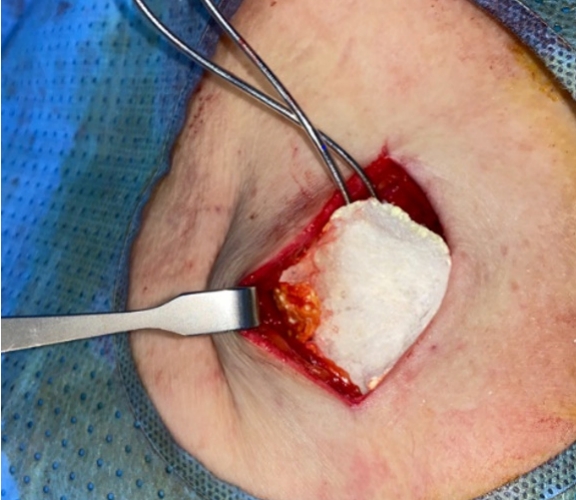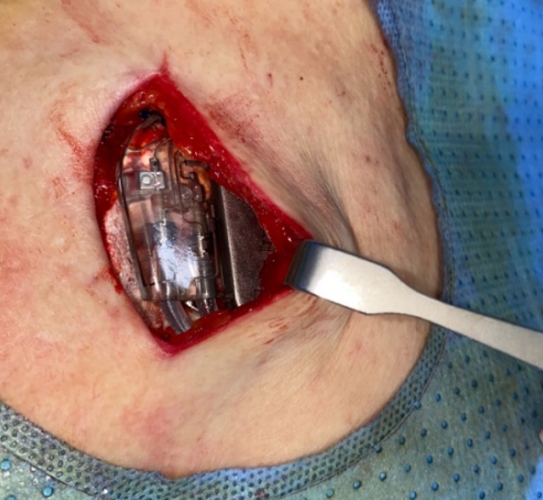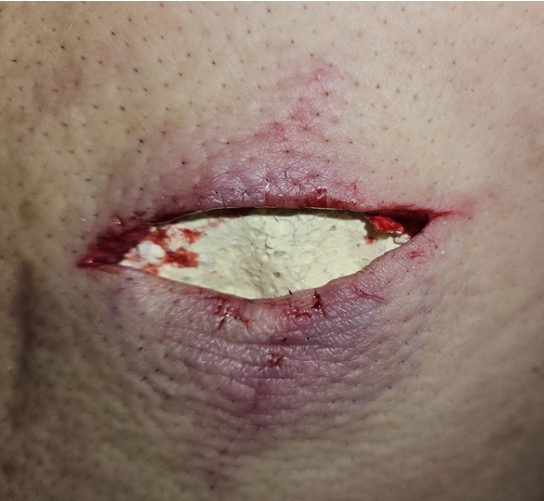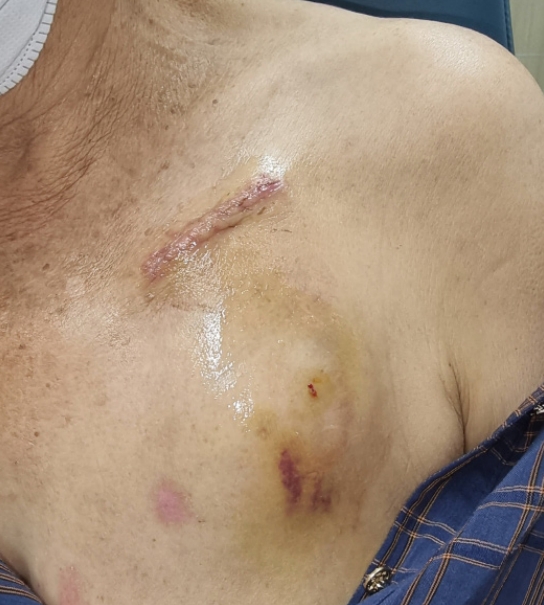Hematoma Prevention Using Tachosil (Fibrin Sealant) Patch during Insertion of Cardiovascular Implantable Electronic Devices without Suspending Antithrombotics: Three Case Reports
Article information
Abstract
Patients undergoing insertion of cardiac implantable electronic devices often exhibit perioperative hemorrhagic complications. Perioperative antithrombotic management, which balances the risk of acute thrombosis and postoperative bleeding, is therefore important for these patients. In this case report, we present three cases of cardiovascular implantable electronic device (CIED) insertion. While the three patients each had different reasons for not discontinuing antithrombotic medications, they all needed CIEDs. During the CIED implantation procedures, a small incision was made on the pectoralis muscle region to obtain a small subcutaneous pocket, and Tachosil, a fibrin sealant patch, was inserted below and above the inserted device. The patients showed no pocket hematoma formation or any hemorrhagic complications. We thus concluded the application of a fibrin sealant patch could be an option for perioperative anticoagulation management without interruption of anticoagulants and antiplatelets.
Introduction
Perioperative complication rates in patients undergoing pacemaker implantation are reportedly 5% to 10% [1]. Perioperative hemorrhagic manifestations are common complications that occur in 1.5% of these patients [1,2]. The majority of patients requiring cardiovascular implantable electronic devices (CIEDs) such as permanent pacemakers, implantable cardioverter-defibrillators (ICDs), cardiac resynchronization therapy (CRT) or defibrillators (CRT-Ds) also take oral anticoagulants such as warfarin, or antiplatelets such as clopidogrel because of diverse indications including congestive heart disease, ventricular tachycardia, or any other disease with a high risk of embolic stroke. Particularly, anticoagulation or antiplatelet therapies before admission contribute to the increased incidence of pocket hematoma after CIED procedures [3]. Therefore, perioperative anticoagulation management in such patients requires an equipoise between the risk of acute thrombosis formation and postoperative hemorrhagic manifestation [4]. In this report, three cases of CIED insertion are presented, for which a Tachosil (fibrin sealant) patch was used in the CIED implantation pocket to prevent postoperative hematoma formation without interrupting antithrombotic medications. In each of these cases, the reasons for continuing antithrombotic medications before the procedure differed; however, CIED insertion was necessary in all cases. This study was approved by the Institutional Review Board of Wonkwang University Hospital (IRB No. WKUH 2022-07-020). The patients provided written informed consent for the publication of this study and the use of their images.
Case
Case 1
A 60-year-old man presented with syncope and associated dizziness. He had undergone mitral valve and aortic valve replacement 21 years prior and had a history of atrial fibrillation and heart failure. At the time of the visit, the patient was taking one 1 mg tablet and another 1.5 mg tablet of warfarin every other day and had fainted a couple of times since the day before he visited the emergency room. The patient had bruises all over his body including his face, but no recollection of the circumstances in which he had fainted. He was diagnosed with sick sinus syndrome and required emergency permanent pacemaker insertion. His medical history indicated a high risk of pocket hematoma formation during pacemaker insertion; however, discontinuing warfarin to reduce the pocket hematoma formation risk could increase the risk of thromboembolism. Considering the patient’s history of double valve replacement and lower international normalized ratio (1.67; target range 2–2.5) [5], the cardiologist decided to proceed without discontinuing warfarin. We explored whether pocket hematoma formation could be prevented using Tachosil, a fibrin sealant mainly used during surgery, and performing pacemaker insertion immediately without postponing the procedure to stop warfarin medication. After preparation on the next day of admission, a small incision was made under local anesthesia on the left prepectoral area. After creating a small subcutaneous pocket for the pacemaker and irrigation, meticulous hemostasis was performed using electrocautery, and lead placement was performed by the cardiologist. Next, a Tachosil patch (45.6 cm2; 9.5×4.8 cm) was compressed to reduce its thickness to 1 mm and then cut in half; half of the patch was then inserted into the pocket (Figs. 1, 2) before insertion of the device. The generator was fit in between the two halves of the Tachosil patch (Fig. 3). Subsequently, a plastic surgeon performed in-layer sutures in the order of fascia, subcutaneous layer, and skin. A #4-0 Vicryl suture was used to suture the subcutaneous layer, and a #6-0 Ethilon suture was used to suture the skin. A sterile compressive dressing was then applied, and the patient’s progress was monitored by a plastic surgeon and cardiologist until discharge (Fig. 4). The patient continued to take warfarin before and after the operation, with the wound remaining clean with slight swelling. The patient was discharged on the 5th postoperative day. At discharge, the wound was clean without any swelling or other complications. No complications, including hematoma formation, were observed on the 10th postoperative day; suture removal was performed at the plastic surgery outpatient clinic. Subsequent follow-up examinations for drug prescription at the cardiology outpatient clinic confirmed that the wound had remained clean even 1 year after the procedure. Thus, the procedure was performed without discontinuing warfarin, and perioperative hemorrhagic complications such as pocket hematoma formation were avoided.
Case 2
A 67-year-old man presented with dizziness. He had a history of chronic kidney disease and cerebral infarction (20 years ago) and had undergone an arteriovenous shunt graft on his left forearm 10 days before admission. He also received cardiopulmonary resuscitation (CPR) 9 months prior because of cardiac arrest when he visited the emergency room with hyperkalemia. The patient was taking one tablet of aspirin (100 mg) and one tablet of clopidogrel (75 mg) every morning at the time of visit. He was diagnosed with sick sinus syndrome and required emergency permanent pacemaker insertion. The patient’s medical history indicated a high risk of pocket hematoma formation during pacemaker insertion; however, discontinuing clopidogrel to reduce pocket hematoma formation risk could increase the risk of thromboembolism. Considering his history of CPR and arteriovenous shunt graft, the nephrologist and the cardiologist decided to proceed without discontinuing clopidogrel. We determined that pocket hematoma formation could be prevented by using Tachosil and performing pacemaker insertion immediately without delaying the procedure to discontinue clopidogrel medication. After preparation on the 4th day of admission, a small incision was made on the left prepectoral area under local anesthesia. A small subcutaneous pocket for the pacemaker was created; subsequently, the same procedure as that used for case 1, including irrigation, was performed (Fig. 5). Next, a sterile compressive dressing was applied, and the patient’s progress was monitored by a plastic surgeon and a cardiologist until discharge. The patient continued to take aspirin and clopidogrel before and after the operation. The wound remained clean with slight swelling. He was discharged on the 5th postoperative day. At discharge, the wound was clean without any swelling or complications. No complications, including hematoma formation, were observed on the 10th postoperative day, and suture removal was performed at the plastic surgery outpatient clinic. Subsequent follow-up examinations for drug prescription at the cardiology outpatient clinic confirmed that the wound had remained clean 1 year after the procedure. Therefore, the procedure was performed without stopping clopidogrel, also preventing perioperative hemorrhagic complications such as pocket hematoma formation.
Case 3
A 54-year-old man presented with bilateral leg weakness accompanied by dizziness and dyspnea. Three months earlier, he had undergone stent insertion due to a myocardial infarction(MI), experiencing symptoms similar to those of a previous MI. The patient was taking one tablet of aspirin (100 mg) every day and one tablet of ticagrelor (60 mg) every day and night at the time of the visit. He was diagnosed with unstable ventricular tachycardia and required emergency ICD insertion. First, he received a 100-J shock for direct-current cardioversion, which was successful. Owing to his history of cardioversion and MI, the patient was expected to have a high risk of pocket hematoma formation during ICD insertion; however, stopping ticagrelor could increase the risk of thromboembolism. Therefore, the cardiologist decided to proceed without discontinuing ticagrelor. We hypothesized that using Tachosil could mainly prevent perioperative pocket hematoma formation, and pacemaker insertion could be performed immediately without delaying the procedure to stop ticagrelor medication. After preparation on the 4th day of admission, a small incision was made on the left prepectoral area under local anesthesia. A small subcutaneous pocket for the pacemaker was made, and the same procedure as that used for case 1 was performed. A sterile compressive dressing was applied afterwards, and the patient’s progress was monitored by a plastic surgeon and cardiologist until discharge. The patient continued to take aspirin and ticagrelor before and after the operation; the wound remained clean with a slight swelling. He was discharged on the 5th postoperative day. At discharge, the wound was clean without any swelling or complications. No hematoma formation nor any other complications were observed on the 10th postoperative day, and suture removal was performed at the plastic surgery outpatient clinic. Follow-up examinations for drug prescription at the cardiology outpatient clinic confirmed that the wound had remained clean even 1 year after the procedure. Ultimately, the procedure was performed without discontinuing ticagrelor, and perioperative hemorrhagic complications such as pocket hematoma formation were avoided.
Discussion
Despite the increasing number of CIED implantations and replacements worldwide [6], preventing pocket hematoma formation in affected patients is difficult because they often require anticoagulation and antiplatelet treatment with drugs such as warfarin or clopidogrel for the management of severe comorbidities [4,7]. Consequently, perioperative hemorrhagic complications are frequently observed following CIED procedures. Among such complications, the most common, pocket hematoma, has an incidence of up to 15% in some patient subgroups [8,9]. Patients with pocket hematoma formation after the CIED procedure were found to have a high rate of receiving anticoagulation or antiplatelet treatment before admission [3]. When a pocket hematoma is present, the incidence of infection is increased nine-fold [10]; thus, pocket hematoma is one of the most dangerous complications of CIED therapy, resulting in hospitalization, substantial morbidity, and even mortality [11,12].
The incidence of pocket hematoma development is higher in patients with comorbidities such as congestive heart failure, renal failure, and thrombocytopenia [13]. Patients who use low molecular weight heparin, have a low left ventricular ejection fraction, or have structural heart disease are more likely to develop pocket hematomas [14]. Because compressive dressing and similar options are the only treatment modalities currently available for cases of pocket hematomas [9], clinicians aim to reduce the possibility of hematoma formation by mitigating preoperative risk factors and optimizing the procedure.
Before fibrin sealants were used in CIED procedures, many patients developed hematomas despite discontinuing antithrombotics. In one case of a 71-year-old woman, a hematoma began to form at the operation site on the first day after a CRT-D insertion procedure. On the 11th postoperative day, the patient had significant swelling, and aspiration of 22 mL of old blood was necessary (Figs. 6, 7). After aspiration of 18 mL of old blood on the 13th postoperative day and 9 mL on the 18th postoperative day, the hematoma was almost resolved, and no sign of infection was observed. As similar cases piled up, we began to consider using hemostatic agents for CIED insertion in at-risk patients, such as those who failed to stop taking antithrombotics, and performed the procedures in the manner described in this study.
For these reasons, we used the Tachosil patch in the presented cases. Tachosil is an absorbable fibrin sealant patch that reduces scar formation and adhesions, and requires up to 12 weeks to be absorbed. It comprises a mixture of fibrin sealant (tissue sealant; human fibrinogen, human thrombin, Ca2+, and factor XIII) and collagen (passive hemostatic agent) [6,8]. The dissolved fibrinogen and thrombin target the end of the coagulation cascade after contact with fluid. Fibrinogen is broken down into fibrin monomers by thrombin, and thrombin with Ca2+ activates factor XIII to factor XIIIa. Factor XIIIa, in turn, cross-links unstable and soluble fibrin polymers, formed by fibrin monomers, to form stable, insoluble fibrin polymers that form fibrin clots [8,13]. Fibrin affects hemostasis and regulates the inflammatory phase by adjusting monocyte and macrophage activity within the wound-healing process. It works like a growth factor, has a direct effect on angiogenesis, and promotes fibroblast formation, thereby facilitating wound healing [11].
Because Tachosil has never been used in pacemaker insertion, we explored its preventative effects by using it to avoid pocket hematoma formation in high-risk patients who had to continue taking warfarin. The patients reported herein were discharged without any complications on the 5th postoperative day, and on the 10th postoperative day, they visited the plastic surgery outpatient clinic for suture removal. The patients also showed no complications at the wound site in the subsequent follow-up assessment.
The favorable results obtained with Tachosil indicate that other hemostatic agents such as Greenplast Q (human fibrinogen concentrate and thrombin) are also worth considering. Greenplast Q is a hemostatic agent consisting of 95 mg human fibrinogen concentrate and 500 IU thrombin in 1 mg. However, although it can be used in pacemaker insertion, Greenplast Q cannot be precisely divided in half like Tachosil and may flow down to bed of the wound pocket even when sprayed directly on the device. The cost differences when applying these materials to a same sized area is another factor to consider; while Tachosil measures 9.5×4.8 cm for 340,000 KRW (256 USD), only 8 mL of Greenplast Q is available for a similar price which can only cover a smaller area.
In conclusion, our findings suggest that the application of a fibrin sealant patch could decrease or even prevent perioperative hemorrhagic complications, by preventing pocket hematoma formation in patients at the highest risk of embolic stroke who cannot discontinue oral antithrombotic therapy. The ability to perform surgery without interrupting anticoagulants and antiplatelets could potentially yield favorable outcomes for patients. Therefore, the application of a Tachosil patch (fibrin sealant) could be a recommended option for perioperative anticoagulation management that does not interrupt anticoagulants and antiplatelets. Furthermore, we will later design and conduct a prospective study on patients in which a fibrin sealant was used during these procedures.
Notes
This work was supported by Wonkwang University in 2023. Young Cheon Na is an editorial board member of the journal but was not involved in the peer reviewer selection, evaluation, or decision process of this article. No other potential conflicts of interest relevant to this article were reported.







